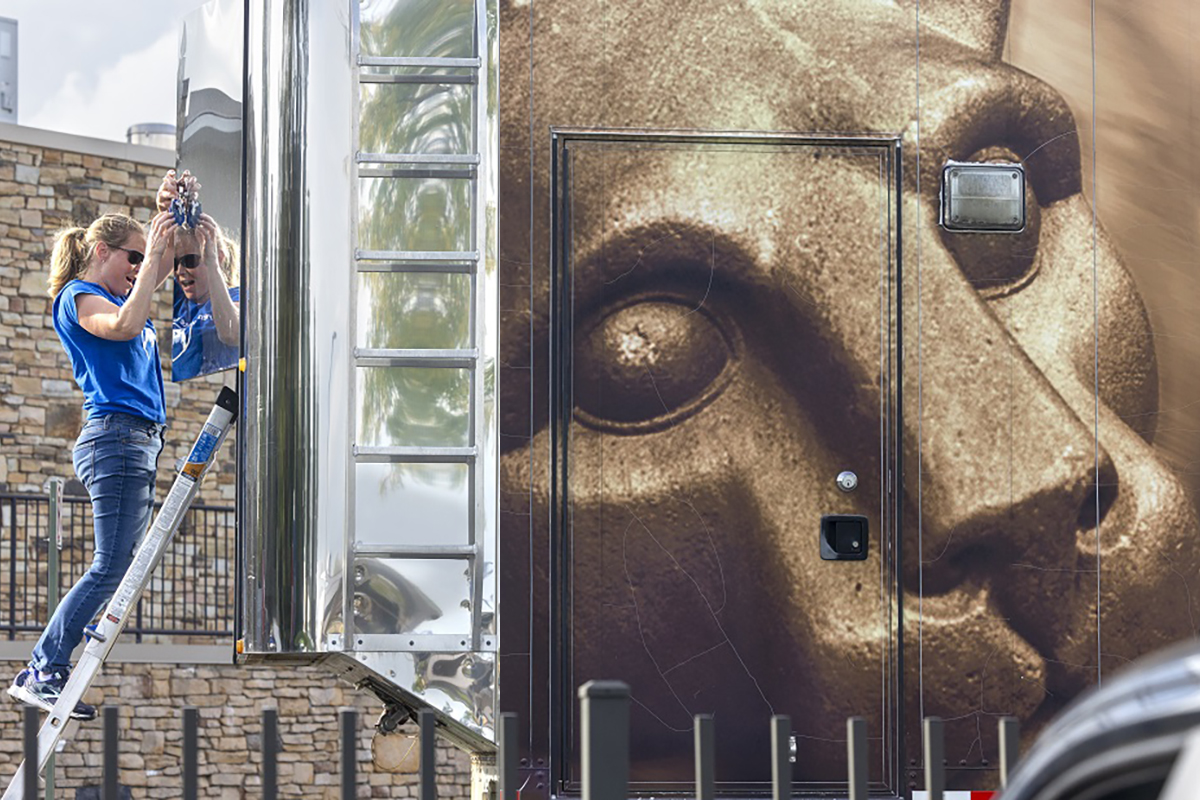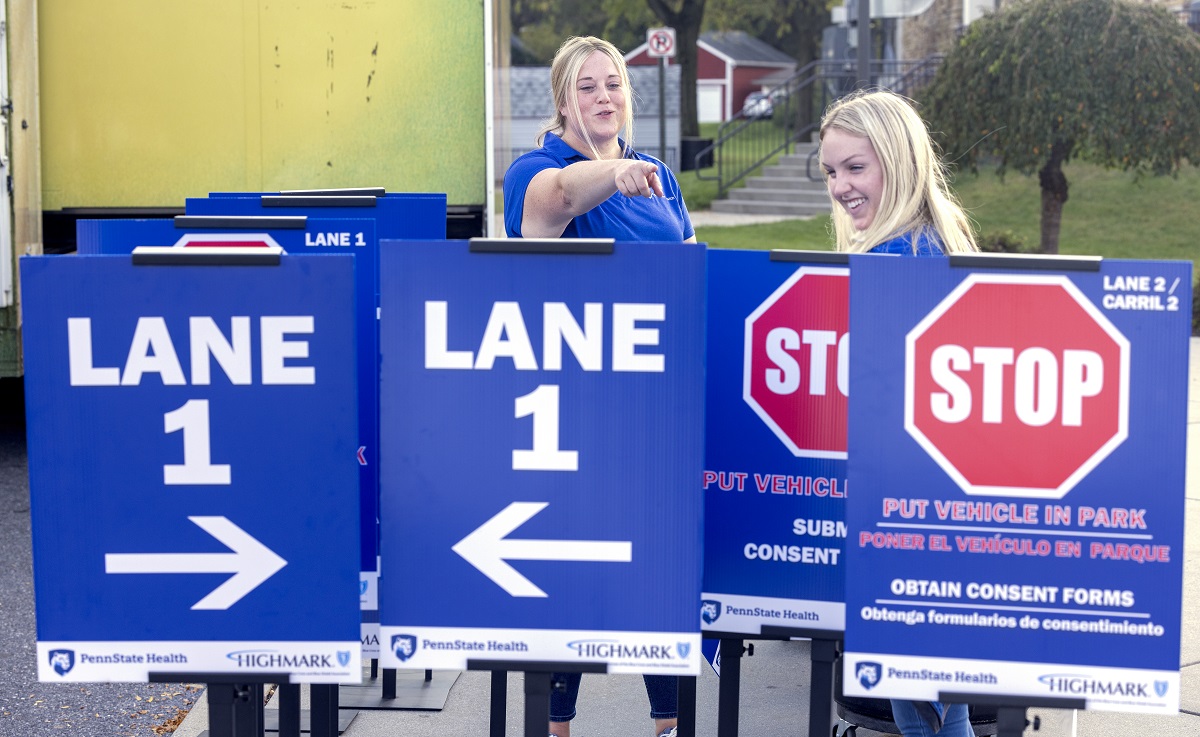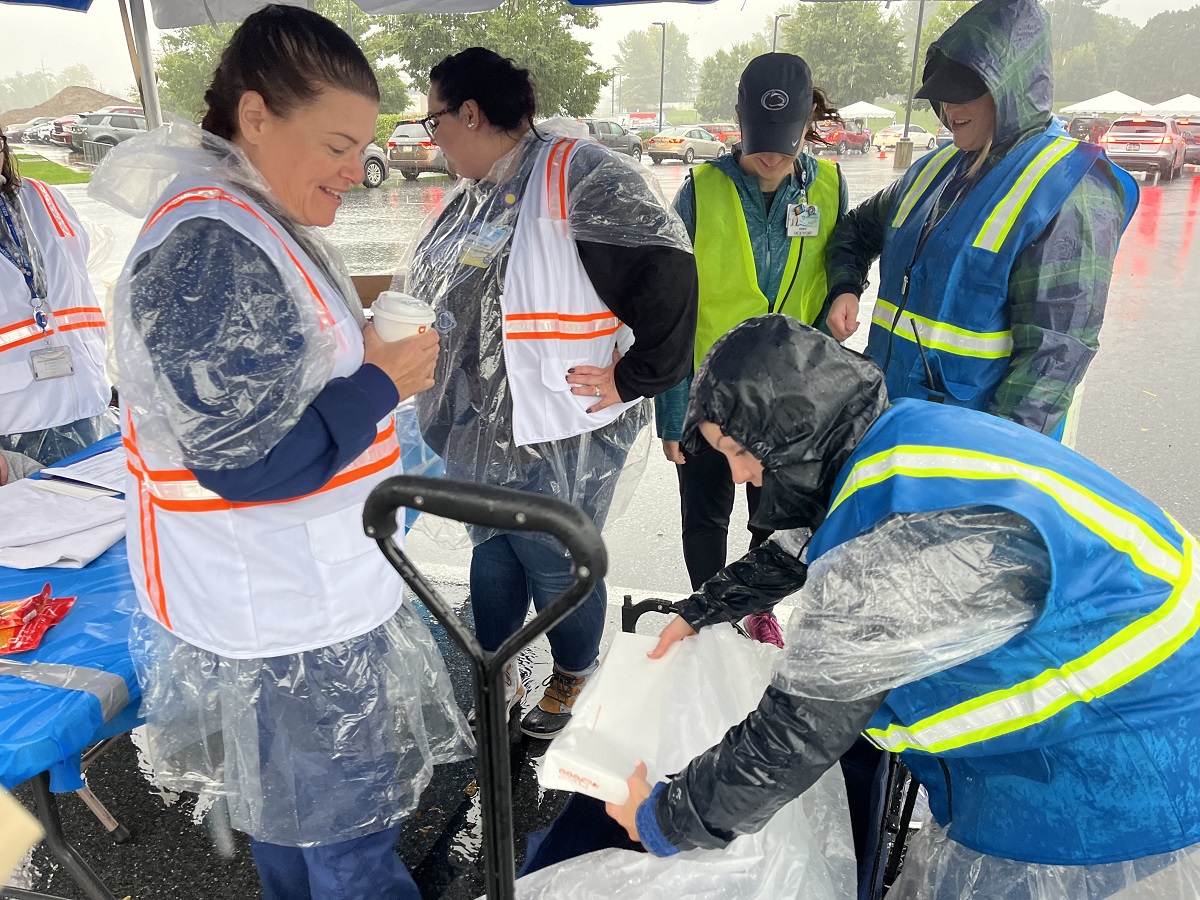Welcome to Penn State Health’s flu shot drive-through. Mind the curves.

Sheets of rain fell on central Pennsylvania early one morning in October, but Mei Nguyen headed out for her parents’ annual flu shot anyway.
Her mother and father are retired, and they’ve reached the age where the flu is more likely to turn into something serious. But rather than visit a nearby doctor’s office, Nguyen opted to take a 30-minute drive from her home in Palmyra to a parking lot outside Lebanon High School to join the line of cars at Penn State Health’s annual drive-through clinic.
“I’ve been doing this for years,” she said. “It’s just very convenient.”
For Nguyen, this step to protect her parents’ health is fast and easy. For the community health nurses and volunteers who make it happen, each stop in the drive-through route is the culmination of months of planning and years of fine-tuning.
It’s worth it, organizers said. This year, the clinic helped protect 583 people from possibly catching and spreading a virus that killed 41,900 people in 2022 and sickened millions more, according to data from the U.S. Centers for Disease Control and Prevention.
Free flu shots are a crucial part of the overall community health picture in Lebanon County and everywhere else. A 2021 Penn State Health survey of six central Pennsylvania counties identified wellness and disease prevention as a key area of need. Dietary issues, such as lack of access to healthy foods, and failure to screen for serious illnesses are also problems for many in the region. A flu outbreak can be devastating to already struggling populations.
That’s why Penn State Health has invested so much time and effort in getting its drive-through right. And every year, the organizers learn a little more.
First stop: Pick a lane
When you first arrive, Scott Mickalonis, director of emergency management and business continuity for Penn State Health, is directing traffic. Droplets bead off of his rain gear. Mickalonis has seen the drive-through evolve. It began in 2015 as an idea and a handful of cars in a parking lot on Penn State Health Milton S. Hershey Medical Center’s campus to the hundreds he’ll help today.

Jessica Wadsworth, rear, community outreach coordinator, and Emilie Woods, community health manager, help set up the signs for the drive-through.
“One of the things we were planning for was how to take care of mass numbers of people,” he said. “Having them park a car, get out and walk in – it’s not efficient. This kind of setup allows for better throughput.”
About 12 hours earlier, when a Penn State Health team arrived to set up, the sky didn’t hold even a rumor of rain. But the forecast made them shift gears.
As the sky opened up, 60 volunteers keep dry inside six tents big enough for cars drive under. It’s the same model they used during the height of COVID for swab testing.
“Things we’ve learned from other experiences help us to pivot,” said Ashley Visco, Penn State Health’s community health director, who has helped oversee the last five flu shot drive-throughs.
Stop 2: Fill out your form
Mickolanis and a few others share a smile and a laugh with you, and then route your car to one of the lanes organizers have created with signs on metal stands and traffic cones. The left lane is for larger SUVs and trucks. The right ― where he routes Nguyen and her parents ― is for smaller cars.
The center lane is for people who speak languages other than English. Several volunteers speak Spanish and help interpret. At Stop No. 2, they wield stacks of consent forms translated into multiple languages.
Drivers fill out the forms on freshly washed clipboards. Several volunteers spend at least a portion of the day wiping down the boards with cleaning solution ― an innovation from the busiest drive-through clinic in 2020. On that day, more than 1,000 people came for flu shots, when sensitivity about the spread of illnesses, always a paramount concern, was heightened.
Stop 3: Any questions?
At your third stop, volunteers answer questions about the vaccine, your paperwork or what’s about to happen in the next tent. Runners collect the forms and take them for checking and filing away at the mobile command center, which is parked nearby.
From the outside, it looks like the rear end of a tractor trailer, 53-feet long and wrapped with images of the Penn State Nittany Lion and the words “LionReach.”
Inside is what looks like a doctor’s office, white cabinetry, antiseptic-colored surfaces and fluorescent lights. The command center is a loaner from Hershey Medical Center’s Emergency Department. On Friday afternoon, as the crew rifled through papers and managed a million tiny details to pull off their event, the generator that powers the lights and outlets wheezed to a halt.
Another curve in the road. Since the drive-through’s inception, everyone has gotten used to taking each unexpected turn as it comes. How do you help people who don’t speak the language? What’s the most efficient way to move each car from paperwork to needles, keeping everything properly sterile, when your hospital is miles away? What if it rains? What if you run out of vaccine?
And now, what do you do when the power goes out?
Heather Hostetter, a community health care administrative associate, and community health nurses Tara Simmons and Julie Groh searched for an answer. Hostetter called someone at the Emergency Department. They tracked down a step ladder, and Hostetter scaled it, digging into the wires under a bulkhead behind the trailer. In a few minutes, the generator roared to life again.
Sometimes, managing a curve requires a change of hats – in this case from administrative associate or nurse to mechanic.
Volunteers come from the community and throughout the health system. They come from the departments of Nursing, Emergency and Pharmacy. A local tent rental provides the tents. Penn State Health partners with the Lebanon School District and local police. Students from Penn State College of Medicine pitch in. Highmark Foundation and Highmark Blue Cross Blue Shield funds it. The Pennsylvania Department of Health plays a role. Each clinic has tendrils leading in countless directions.
Stop 4: Go time
The reason why you’ve come has arrived. The big dance. A nurse gives you your shot.
Early that morning, Frank Herrmann, clinical pharmacy coordinator at Hershey Medical Center, opened a freezer at the hospital, took out 700 doses of the flu vaccine ― more than enough for the 400 who have signed up for the drive-through ― and put them into a foam cooler with ice bags.
Around the country everyone receives the same vaccine. “Each year the Centers for Disease Control and Prevention makes their best guess as to what flu strain is going to be prevalent this season,” Herrmann said. “So, they put this menu together of what they think is going to work.”
In the drive-through, Herrmann and others from the Pharmacy Department make sure each station is stocked with enough vaccine. On the off chance that they run out, more is available at the Medical Center, which is about 25 minutes away by car.
As rain roared on the tent, Penn State Health nurses leaned into Nguyen’s car and injected her and her mother and father with the 2023 flu vaccine.
Despite the downpour and the growing crowd, it took Nguyen about five minutes to pull in, fill out a couple of forms, receive the shots and drive out.
Simple. No waiting rooms. And she didn’t even have to get out of the car.
Providing flu vaccinations is part of the Penn State Health strategy to improve wellness and disease prevention. Learn more in the Penn State Health Community Health Needs Assessment and Implementation Plan.
If you're having trouble accessing this content, or would like it in another format, please email Penn State Health Marketing & Communications.

